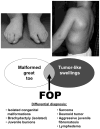Early diagnosis of fibrodysplasia ossificans progressiva
- PMID: 18450872
- PMCID: PMC3502043
- DOI: 10.1542/peds.2007-1980
Early diagnosis of fibrodysplasia ossificans progressiva
Abstract
Background: Fibrodysplasia ossificans progressiva is a rare and disabling genetic condition characterized by congenital malformation of the great toes and by progressive heterotopic ossification in specific anatomic patterns. Most patients with fibrodysplasia ossificans progressiva are misdiagnosed early in life before the appearance of heterotopic ossification and undergo diagnostic procedures that can cause lifelong disability. Recently, the genetic cause of fibrodysplasia ossificans progressiva was identified, and definitive genetic testing for fibrodysplasia ossificans progressiva is now available before the appearance of heterotopic ossification.
Methods: We recently evaluated 7 children for diagnosis of fibrodysplasia ossificans progressiva before the onset of heterotopic ossification. A medical history, physical examination, and skeletal survey were obtained on all of the patients, as well as clinical genetic testing for the canonical fibrodysplasia ossificans progressiva mutation.
Results: All 7 of the children (4 girls and 3 boys; ages 3 months to 6 years) had congenital malformations of the great toes, but none had radiographic evidence of heterotopic ossification at the time of evaluation. Five of the 7 children had soft tissue lesions of the neck and back, suggestive of early fibrodysplasia ossificans progressiva flare-ups, 3 of whom had undergone invasive diagnostic procedures that exacerbated their condition. Two children had no history or signs of soft tissue swelling or flare-ups. DNA sequence analysis found that all 7 of the children had the recurrent fibrodysplasia ossificans progressiva missense mutation, a single nucleotide substitution (c.617G>A) at codon 206 in the glycine-serine activation domain of activin receptor IA, a bone morphogenetic protein type 1 receptor.
Conclusion: Clinical suspicion of fibrodysplasia ossificans progressiva early in life on the basis of malformed great toes can lead to early clinical diagnosis, confirmatory diagnostic genetic testing, and the avoidance of additional harmful diagnostic and treatment procedures. This is the first report of genetic confirmation of fibrodysplasia ossificans progressiva before the appearance of heterotopic ossification. Pediatricians should be aware of the early diagnostic features of fibrodysplasia ossificans progressiva, even before the appearance of heterotopic ossification. This awareness should prompt early genetic consultation and testing and the institution of assiduous precautions to prevent iatrogenic harm.
Figures



Similar articles
-
Evaluation of 20 years experience of fibrodysplasia ossificans progressiva in Iran: lessons for early diagnosis and prevention.Clin Rheumatol. 2012 Jul;31(7):1133-7. doi: 10.1007/s10067-012-1968-6. Epub 2012 Apr 20. Clin Rheumatol. 2012. PMID: 22526474
-
Fibrodysplasia ossificans progressiva (stone man syndrome): a case report.J Med Case Rep. 2019 Dec 1;13(1):364. doi: 10.1186/s13256-019-2297-z. J Med Case Rep. 2019. PMID: 31785620 Free PMC article.
-
Proximal tibial osteochondromas in patients with fibrodysplasia ossificans progressiva.J Bone Joint Surg Am. 2008 Feb;90(2):366-74. doi: 10.2106/JBJS.G.00774. J Bone Joint Surg Am. 2008. PMID: 18245597 Free PMC article.
-
Fibrodysplasia ossificans progressiva: a current review of imaging findings.Skeletal Radiol. 2018 Aug;47(8):1043-1050. doi: 10.1007/s00256-018-2889-5. Epub 2018 Feb 14. Skeletal Radiol. 2018. PMID: 29445932 Review.
-
Fibrodysplasia ossificans progressiva: clinical and genetic aspects.Orphanet J Rare Dis. 2011 Dec 1;6:80. doi: 10.1186/1750-1172-6-80. Orphanet J Rare Dis. 2011. PMID: 22133093 Free PMC article. Review.
Cited by
-
Insights from a rare genetic disorder of extra-skeletal bone formation, fibrodysplasia ossificans progressiva (FOP).Bone. 2008 Sep;43(3):427-33. doi: 10.1016/j.bone.2008.05.013. Epub 2008 May 28. Bone. 2008. PMID: 18590993 Free PMC article. Review.
-
Mutation Detection in Activin A Receptor, Type I (ACVR1) Gene in Fibrodysplasia Ossificans Progressiva in An Iranian Family.Cell J. 2014 Feb 3;16(1):91-4. Epub 2014 Feb 3. Cell J. 2014. PMID: 24518978 Free PMC article.
-
NGF-TrkA signaling dictates neural ingrowth and aberrant osteochondral differentiation after soft tissue trauma.Nat Commun. 2021 Aug 16;12(1):4939. doi: 10.1038/s41467-021-25143-z. Nat Commun. 2021. PMID: 34400627 Free PMC article.
-
Fibrodysplasia ossificans progressiva: a case report.Ghana Med J. 2016 Dec;50(4):248-250. doi: 10.4314/gmj.v50i4.8. Ghana Med J. 2016. PMID: 28579631 Free PMC article.
-
Fibrodysplasia Ossificans Progressiva and Pregnancy: A Case Series and Review of the Literature.Case Rep Obstet Gynecol. 2022 Sep 16;2022:9857766. doi: 10.1155/2022/9857766. eCollection 2022. Case Rep Obstet Gynecol. 2022. PMID: 36159183 Free PMC article.
References
-
- Cohen RB, Hahn GV, Tabas J, et al. The natural history of heterotopic ossification in patients who have fibrodysplasia ossificans progressiva. J Bone Joint Surg. 1993;75(2):215– 219. - PubMed
-
- Rocke DM, Zasloff M, Peeper J, Cohen RB, Kaplan FS. Age and joint-specific risk of initial heterotopic ossification in patients who have fibrodysplasia ossificans progressiva. Clin Orthop Rel Res. 1994;301:243–248. - PubMed
-
- Kaplan FS, Strear CM, Zasloff MA. Radiographic and scinti-graphic features of modeling and remodeling in the heterotopic skeleton of patients who have fibrodysplasia ossificans progressiva. Clin Orthop Rel Res. 1994;304:238–247. - PubMed
-
- Mahboubi S, Glaser DL, Shore EM, Kaplan FS. Fibrodysplasia ossificans progressiva. Pediatr Radiol. 2001;31(5):307–314. - PubMed
-
- Kaplan FS, Glaser DL, Shore EM, et al. The phenotype of fibrodysplasia ossificans progressiva. Clin Rev Bone Miner Metab. 2005;3(3– 4):183–188.
Publication types
MeSH terms
Grants and funding
LinkOut - more resources
Full Text Sources
Other Literature Sources

